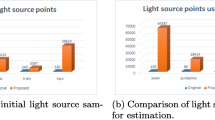Abstract
Image binarization of uneven lighted images, using thresholding techniques, is still a challenging task. Adaptive thresholding methods are the widely adopted approaches for binarization of uneven lighting images. However, the efficacy of these adaptive thresholding methods is highly sensitive to the criteria function used for measuring the bimodal property of the gray level distribution of a local region. In this paper, we propose Gaussian Mixture Model (GMM) which is based on adaptive thresholding for binarizing uneven lighting images. The proposed GMM based criteria function efficiently partitioning the uneven light images into bimodal and unimodal subimages with low uneven light effect. At first, the bimodal subimages are binarized using Otsu’s thresholding approach, followed by unimodal subimages being thresholded using the bilinear interpolation of neighbouring thresholds of bimodal subimages. Next a fast Expectation Maximization(EM) algorithm is developed to reduce the computational complexity of the GMM. Experimental results on different uneven light images demonstrate that the proposed adaptive thresholding outperforms the other considered methods with an avg. misclassification error of 1.68 % and an average computation time of 1.50 seconds. The computational time can be further reduced by a specially purposed hardware and parallel processing of each subimages for real time applications.












Similar content being viewed by others
References
Sahoo, P.K., Soltani, S., & Wong, A.K. (1988). A survey of thresholding techniques. Computer Graphics and Image Processing, 41, 233–60.
Sezgin, M., & Sankar, B (2004). Survey over image thresholding techniquesand quantitative performance evaluation. Journal of Electronic Imaging, 13, 146–65.
Bardera, A., Boada, I., Feixas. M., & sbert, M. (2009). Image segmentation using excess entropy. Journal of Signal Processing Systems, 54, 205–214.
Otsu, N (1979). A threshold selection method from gray-level histograms. IEEE Transactions on Systems, Man, and Cybernetics: Systems, 9, 62–66.
Kittler, J. (1986). Minimum error thresholding. Pattern Recognition, 19(1), 41–47.
Niblack, W. (1986). An introduction to digital Image Processing. EnglewoodCliffs: Prentice Hall.
Sauvola, J (2000). Adaptive document binarisation. Pattern Recognition, 33, 225–236.
Bradley, D., & Roth, G (2007). Adaptive thresholding using the integral image. Journal of Graphics Tool, 12, 13–21.
Chan, C. (2019). Memory-efficient and fast implementation of local adaptive binarization methods, 1-8.
Zheng, J., Zhang, D., & Huang, K. (2016). Adaptive windowed range constrained otsu method using local information. Journal of Electronic Imaging, 25, 013034–1–0134-11.
Zheng, J., Zhang, D., & Huang, K (2018). Adaptive image segmentation method based on the fuzzy c-means with spatial information. IET Image Processing, 12(5), 785–792.
Bogiatzis, A., & Papadopoulos, B. k. (2019). Local thresholding of degraded or unevenly illuminated documents using fuzzy inclusion and entropy measures. Evolving Systems, 10(4), 593–619.
Zhao, L., Zheng, S., & Vang, W (2019). An image thresholding approach based on gaussian mixture model. Pattern Analysis and Application, 22, 75–88.
Yanowitz, S.D., & Bruckstein, A.M. (1989). A new method for image segmentation. Computer Graphics and Image Processing, 46, 82–95.
Blayvas, I., Bruckstein, A., & Kimmel, R (2006). Efficient computation of adaptive threshold surfaces for image binarization. Pattern Recognition, 39(1), 89–101.
Yazid, H., & Arof, H. (2013). Gradient based adaptive thresholding. Journal of Visual Communication and Image Representation, 32, 926–936.
Brain, W (2019). Adaptive thresholding using Quadratic cost Function. International Journal of Image Processing, 13(5), 76–102.
Huang, Q.G., & Cai, W. (2005). Thresholding technique with adaptive window selection for uneven lighting image. Pattern Recognition Letters, 28, 801–08.
Kanungo, P., Nanda, P.K., & Ghosh, A (2010). Parallel genetic algorithm based adaptive thresholding for image segmentation under uneven lighting conditions. In IEEE international conference on systems, man and cybernetics (pp. 1904–1911).
Xing, J., Yang, P., & Qingge, L. (2020). Robust 2D Otsu’s Algorithm for uneven illumination image segmentation. Computational Intelligence and Neuroscience, 1–14. https://doi.org/10.1155/2020/5047976.
He, S., & Schomaker, L. (2019). Deep otsu: document enhancement and binarization using iterative deep learning. Pattern Recognition, 91, 379–390.
Xiong, W., Xu, J., Xiong, Z., Wang, J., & Liu, M. (2018). Degraded historical document image binarization using local features and support vector machines. Optik, 164, 218–223.
Tung, H.-C., & Lin, Y.-G. (2018). Efficiennt uneven image binarization by support vector machines. Journal of Information and optimization Sciences, 39(2), 519–543.
Ahmed, I., Ahmed, M., khan, A.F., & Asif, M (2020). Comparision of deep learning based segmentation models:using top view person images. IEEE Access, 8, 136361–136373.
Fu, Z., & Liming, W. (2012). Color image segmentation using Gaussian mixture model and EM Algorithm. In International conference on multimedia and signal processing. CMSP, (Vol. 346 pp. 61–66).
Martin. (2007). Berkeley Segmentation Dataset http://www2.eecs.berkeley.edu/Research/projects/CS/vision/bsds/ [Access:2007].
Alpert. (2007). Weizmann Segmentation Evaluation Database, http://www.wisdom.weizmann.ac.il/~vision/Seg-Evaluation-DB [Access:2007].
Author information
Authors and Affiliations
Corresponding author
Additional information
Publisher’s Note
Springer Nature remains neutral with regard to jurisdictional claims in published maps and institutional affiliations.
Rights and permissions
About this article
Cite this article
Pattnaik, T., Kanungo, P. GMM Based Adaptive Thresholding for Uneven Lighting Image Binarization. J Sign Process Syst 93, 1253–1270 (2021). https://doi.org/10.1007/s11265-021-01700-z
Received:
Revised:
Accepted:
Published:
Issue Date:
DOI: https://doi.org/10.1007/s11265-021-01700-z




